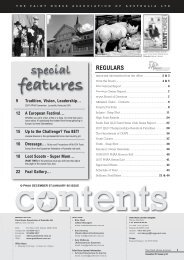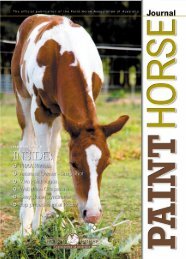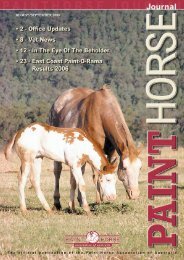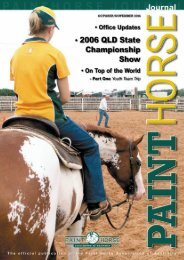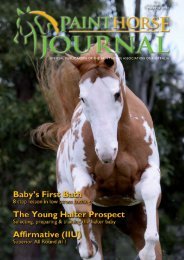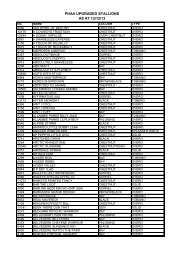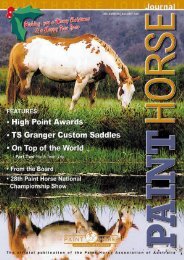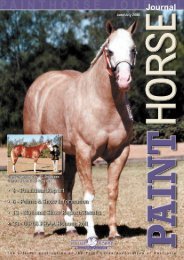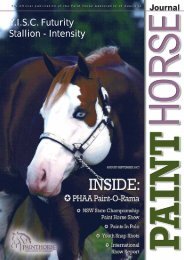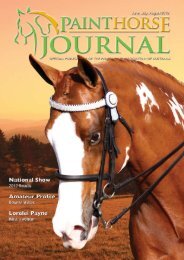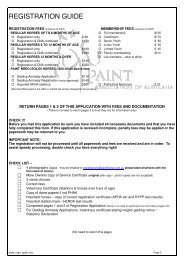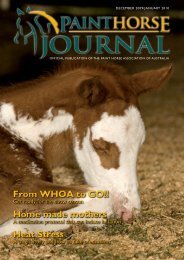Acres of Clover ⢠Photo by: Stefan & Barbara Wielebinski
Acres of Clover ⢠Photo by: Stefan & Barbara Wielebinski
Acres of Clover ⢠Photo by: Stefan & Barbara Wielebinski
You also want an ePaper? Increase the reach of your titles
YUMPU automatically turns print PDFs into web optimized ePapers that Google loves.
● FEATURE<br />
ARTICLE BY: Michal Prochazka, MD, Founder & Director, Pet DNA Services <strong>of</strong> Az, Tempe, Arizona (www.petdnaservicesaz.com).<br />
ARTICLE SOURCED BY: LEE ANN HALL<br />
Over the last couple <strong>of</strong> decades,<br />
advances in genetics technology made<br />
it possible for DNA testing to become<br />
the method <strong>of</strong> choice for a variety <strong>of</strong><br />
applications, ranging from human<br />
medicine and forensics to our hobbies<br />
involving pets and domestic animals.<br />
In this article, I have attempted<br />
to present a simple overview <strong>of</strong><br />
the use <strong>of</strong> DNA tests in horses.<br />
w<br />
WHEN talking about genetics and DNA testing, one cannot<br />
avoid the use <strong>of</strong> specialized vocabulary, which I will explain<br />
briefly, before discussing the applications <strong>of</strong> this technology<br />
in our equine friends.<br />
Practically every cell in the body contains DNA, which is the<br />
“blueprint” code <strong>of</strong> instructions determining the appearance<br />
and function <strong>of</strong> an organism. The DNA is arranged in rodlike<br />
structures called chromosomes located in the nucleus.<br />
Chromosomal segments carrying discrete codes for<br />
specific traits and functions are called genes, and with the<br />
exception <strong>of</strong> the sex chromosomes all <strong>of</strong> the other<br />
chromosomes (and genes) in animals and humans are<br />
present in pairs, with each parent contributing one half <strong>of</strong><br />
the material. In general, both copies <strong>of</strong> a gene are identical,<br />
but some carry discrete differences (mutations, variants),<br />
some <strong>of</strong> which can result in visible differences – for<br />
example a variation in the coat color. Such alternate variant<br />
forms <strong>of</strong> the same gene are called alleles, and an individual<br />
is referred to as a homozygote when both alleles in a pair<br />
are the same, whereas an individual carrying two different<br />
alleles <strong>of</strong> the same gene is called a heterozygote.<br />
Depending on their biological properties, two alleles at any<br />
gene can interact in different ways. An allele is dominant<br />
when in a heterozygote carrier only this allele will show an<br />
effect. Furthermore, its effect is the same, regardless<br />
whether the individual has one or two copies <strong>of</strong> such allele<br />
(= is either a heterozygote or a homozygote for it).<br />
Conversely, an allele which is masked <strong>by</strong> its dominant<br />
counterpart is called recessive, and the effect can only be<br />
visible in a homozygote. A special situation is that <strong>of</strong><br />
incomplete dominance, when one allele shows a certain<br />
effect in a heterozygote, but the expression is more<br />
pronounced when the carrier is a homozygote (a typical<br />
example in horses is the Cream Dilution).<br />
The combination <strong>of</strong> alleles at one or more genes is referred<br />
to as genotype, while the visible manifestation <strong>of</strong> their<br />
effects is called phenotype. Due to interactions between<br />
The Paint Horse Journal 31<br />
April/May 2008



